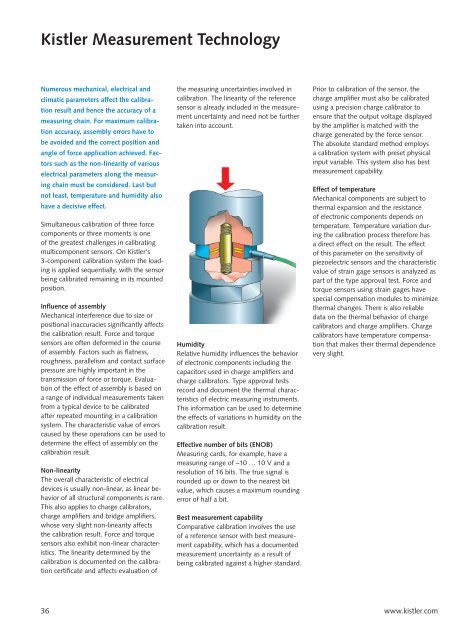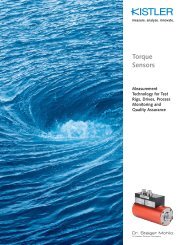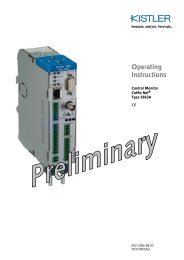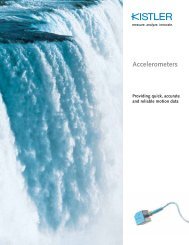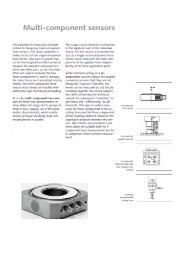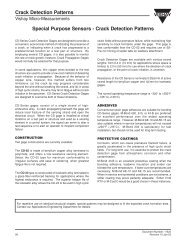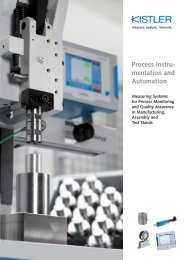Measuring - sensitec
Measuring - sensitec
Measuring - sensitec
You also want an ePaper? Increase the reach of your titles
YUMPU automatically turns print PDFs into web optimized ePapers that Google loves.
Kistler Measurement Technology<br />
Numerous mechanical, electrical and<br />
climatic parameters affect the calibration<br />
result and hence the accuracy of a<br />
measuring chain. For maximum calibration<br />
accuracy, assembly errors have to<br />
be avoided and the correct position and<br />
angle of force application achieved. Factors<br />
such as the non-linearity of various<br />
electrical parameters along the measuring<br />
chain must be considered. Last but<br />
not least, temperature and humidity also<br />
have a decisive effect.<br />
Simultaneous calibration of three force<br />
components or three moments is one<br />
of the greatest challenges in calibrating<br />
multicomponent sensors. On Kistler‘s<br />
3-component calibration system the loading<br />
is applied sequentially, with the sensor<br />
being calibrated remaining in its mounted<br />
position.<br />
Influence of assembly<br />
Mechanical interference due to size or<br />
positional inaccuracies significantly affects<br />
the calibration result. Force and torque<br />
sensors are often deformed in the course<br />
of assembly. Factors such as flatness,<br />
roughness, parallelism and contact surface<br />
pressure are highly important in the<br />
transmission of force or torque. Evaluation<br />
of the effect of assembly is based on<br />
a range of individual measurements taken<br />
from a typical device to be calibrated<br />
after repeated mounting in a calibration<br />
system. The characteristic value of errors<br />
caused by these operations can be used to<br />
determine the effect of assembly on the<br />
calibration result.<br />
Non-linearity<br />
The overall characteristic of electrical<br />
devices is usually non-linear, as linear behavior<br />
of all structural components is rare.<br />
This also applies to charge calibrators,<br />
charge amplifiers and bridge amplifiers,<br />
whose very slight non-linearity affects<br />
the calibration result. Force and torque<br />
sensors also exhibit non-linear characteristics.<br />
The linearity determined by the<br />
calibration is documented on the calibration<br />
certificate and affects evaluation of<br />
the measuring uncertainties involved in<br />
calibration. The linearity of the reference<br />
sensor is already included in the measurement<br />
uncertainty and need not be further<br />
taken into account.<br />
Humidity<br />
Relative humidity influences the behavior<br />
of electronic components including the<br />
capacitors used in charge amplifiers and<br />
charge calibrators. Type approval tests<br />
record and document the thermal characteristics<br />
of electric measuring instruments.<br />
This information can be used to determine<br />
the effects of variations in humidity on the<br />
calibration result.<br />
Effective number of bits (ENOB)<br />
<strong>Measuring</strong> cards, for example, have a<br />
measuring range of –10 … 10 V and a<br />
resolution of 16 bits. The true signal is<br />
rounded up or down to the nearest bit<br />
value, which causes a maximum rounding<br />
error of half a bit.<br />
Best measurement capability<br />
Comparative calibration involves the use<br />
of a reference sensor with best measurement<br />
capability, which has a documented<br />
measurement uncertainty as a result of<br />
being calibrated against a higher standard.<br />
Prior to calibration of the sensor, the<br />
charge amplifier must also be calibrated<br />
using a precision charge calibrator to<br />
ensure that the output voltage displayed<br />
by the amplifier is matched with the<br />
charge generated by the force sensor.<br />
The absolute standard method employs<br />
a calibration system with preset physical<br />
input variable. This system also has best<br />
measurement capability.<br />
Effect of temperature<br />
Mechanical components are subject to<br />
thermal expansion and the resistance<br />
of electronic components depends on<br />
temperature. Temperature variation during<br />
the calibration process therefore has<br />
a direct effect on the result. The effect<br />
of this parameter on the sensitivity of<br />
piezoelectric sensors and the characteristic<br />
value of strain gage sensors is analyzed as<br />
part of the type approval test. Force and<br />
torque sensors using strain gages have<br />
special compensation modules to minimize<br />
thermal changes. There is also reliable<br />
data on the thermal behavior of charge<br />
calibrators and charge amplifiers. Charge<br />
calibrators have temperature compensation<br />
that makes their thermal dependence<br />
very slight.<br />
36 www.kistler.com


